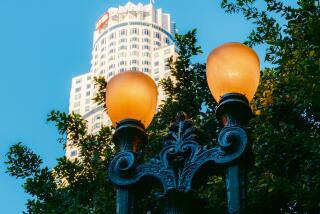Bright Idea’s on the Right Track
- Share via
Anyone who has ever seen a klieg light knows--or thinks he knows--the purpose of track lighting. Klieg lights are those screaming high-intensity carbon lamps that movie crews use to make a scene that is being shot in bright daylight appear even brighter.
If you live in Southern California long enough, you’ll eventually run into a location shoot, pause to watch the lighting guys at work, and come away shaking your head. Why, you’ll wonder, are they flooding the scene with lamps that look like artillery pieces and that ratchet the temperature up to about 180 degrees when it’s the middle of August, the sun is radiating blindingly through a cloudless sky and it’s already 98 in the shade?
The only way to survive this beaming assault is to wear enough makeup to coat a medium-sized airliner, which is why the people with the No. 98 pancake are always hovering at the ready. It becomes obvious pretty quickly that these big guns of illumination are made to be aimed at things rather than to diffuse soft and flattering light over an indistinct area.
When you are in the carbon arc, you are bathed in crashing light, exposed like a fly on a pin, and you may feel like a bad vaudevillian who has forgotten the punch line.
Consequently, if you’re not the type of person who is likely to instinctively break into a time step when the lights are switched on, you’re probably a bit leery of track lighting. But, says Roger Green, of Lighting Design of California in San Juan Capistrano, the idea in track lighting isn’t to flood a room like a runway at night, but to direct the eye to certain things that are worth seeing.
“Ideally,” he said, “it’s used for highlighting as opposed to general lighting. I like to use it to bounce off nice, reflective walls, directed either up or down. The lamps give off good, white light that’s good for color rendition. You can light paintings or pictures or pin-spot flower arrangements.”
Green admits that a lot of people are put off by the bulky look of the light itself, which may or may not remind them of the time they were humiliated in first grade when they forgot their lines under the spotlight while playing the Jolly Carrot in the school nutrition pageant.
However, he said, relief has appeared in miniature form. Less, once again, has turned out to be more.
“Low voltage in the last few years has really done a number on better lighting,” said Green, “especially on the residential side.”
Low voltage means small size and greater flexibility in lighting a room, said Green. The lamps are smaller and less intrusive visually, the light is less glaring and the beam can be directed at a specific object from a longer distance away.
“It’s the actual lamp that does the work, and that’s what a lot of people don’t understand,” said Green. “A lot of people aren’t necessarily concerned with the lamp, and they buy track lighting because they like the look of the track (ead.”
(Nomenclature explanation: in lighting talk, a lamp is the part that actually glows--we non-lighting folk would call it a bulb--and the track head is the cylindrical part that surrounds the bulb . . . uh, lamp.)
The track head in low-voltage lights can be tiny because the lamp is tiny. However, its output is undiminished. Also, said Green, low-voltage lamps can be directed at items across a room and can illuminate them specifically, much like a pin spot in a theater.
He has a favorite low-voltage model. Called a Par 36, it has a filament on the front of the lamp that enables you to stare at it from a shallow angle--Green says as little as 3 inches to one side--and not be blinded or dazzled by the beam.
Track lighting also does not necessarily need to employ a track. If you don’t like the look of the track bolted to your ceiling, said Green, it’s possible to anchor individual track heads anywhere you want. However, he said, the advantage of the track lies in the ability to move the individual track heads along it for different lighting emphasis if, for instance, you decide to replace the dogs-playing-poker painting with a Renoir.
How much can it all cost? Green laughs at that one. How high is up? With a regular incandescent system consisting of a single 4-foot track and a couple of track heads, you can expect to spend as little as $70. Halogen lamps will run more and low-voltage systems more still. A single low-voltage lamp with a built-in transformer can cost as much as $100.
Lighting an average living room with track lighting, said Green, can run anywhere from less than $100 to more than $500.
Of course, if you have even one smudge of greasepaint in your blood--or if you’re just vain--it could be possible to let a track lighting job get out of hand. If you hire an installer with a sense of humor you could theoretically sing in the shower, play the Frugal Gourmet in the kitchen and waltz on the patio (we won’t discuss the bedroom), all under the pointed and theatrical glow of judiciously placed track heads.
Just forget the No. 98 pancake.
More to Read
Sign up for The Wild
We’ll help you find the best places to hike, bike and run, as well as the perfect silent spots for meditation and yoga.
You may occasionally receive promotional content from the Los Angeles Times.




